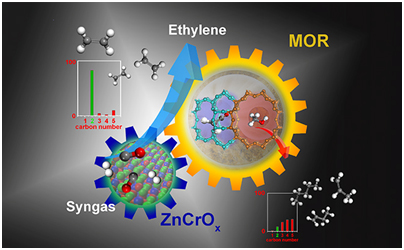Recently, Prof. Pan and Prof. Bao et al. have made progress in selective syngas conversion to ethylene via OX-ZEO process. Such results are published in Angewandte Chemie-International Edition(2018, 57(17), 4692-4696) as "Hot Paper".

Controlled C-C coupling is always the key challenge in C1 chemistry especially for efficient utilization of syngas from coal, natural gas and biomass. This work builds upon the OX-ZEO concept reported previously by the team that separating the C-O activation as well as C-C coupling onto metal oxides and zeolites during syngas conversion. In this way, high selective of mixed light olefins (C2=-C4=)(Science 351 (2016) 1065-1068; ACS Catalysis 7 (2017) 2800-2804) and aromatics (Chemical Communication 53 (2017) 11146-11149)can be achieved. Herein, the research team steered the product selectivity towards ethylene by employing ZnCrOx-mordenite (MOR) bifunctional catalysts. The selectivity of ethylene alone reaches as high as 73% among other hydrocarbons at a 26% CO conversion. This selectivity is significantly higher than those obtained in any other direct syngas conversion or the multistep process methanol-to-olefin conversion. This highly selective pathway is realized over the catalytic sites within the 8-membered ring (8MR) side pockets of MOR via a ketene intermediate rather than methanol in the 8MR or 12MR channels. This study provides substantive evidence for a new type of syngas chemistry with ketene as the key reaction intermediate and enables extraordinary ethylene selectivity within the OX-ZEO catalyst framework. Moreover, this work again demonstrated the OX-ZEO concept as a new platform for better utilizing coal via syngas.
This work was financially supported by the Ministry of Science and Technology of China and the National Natural Science Foundation of China.(By Feng Jiao)